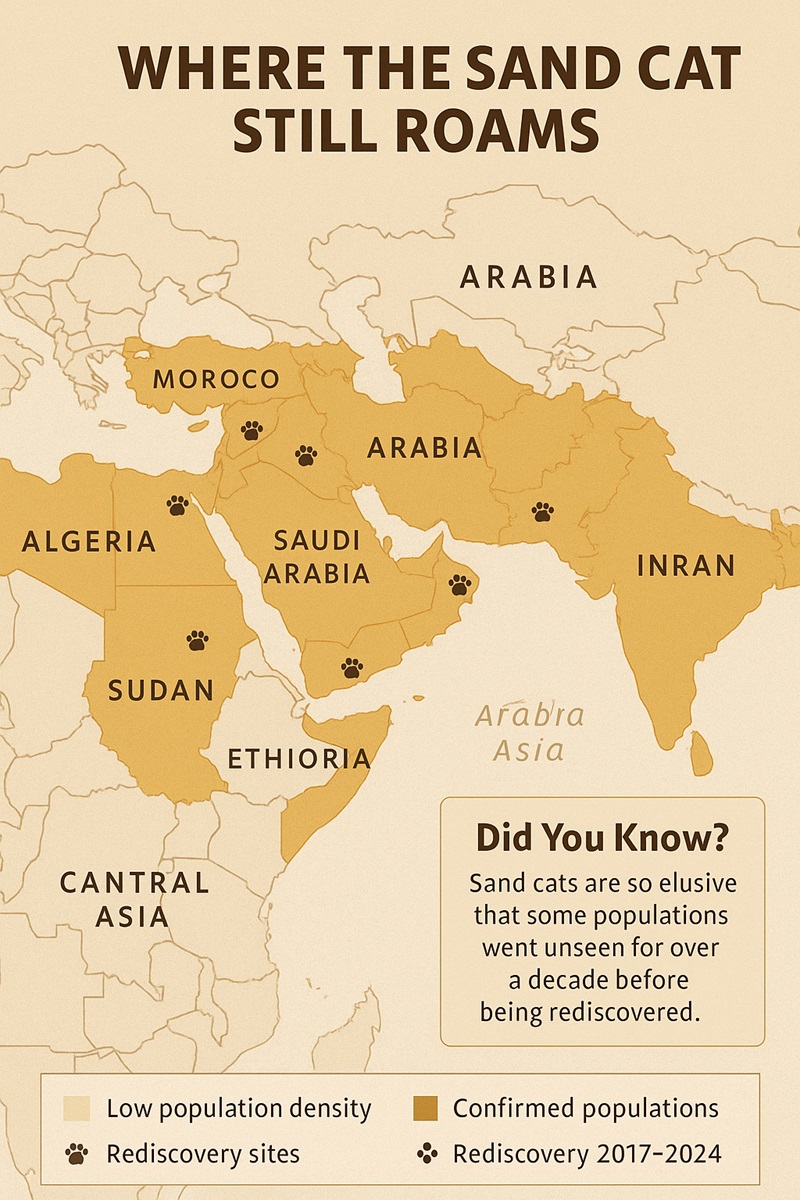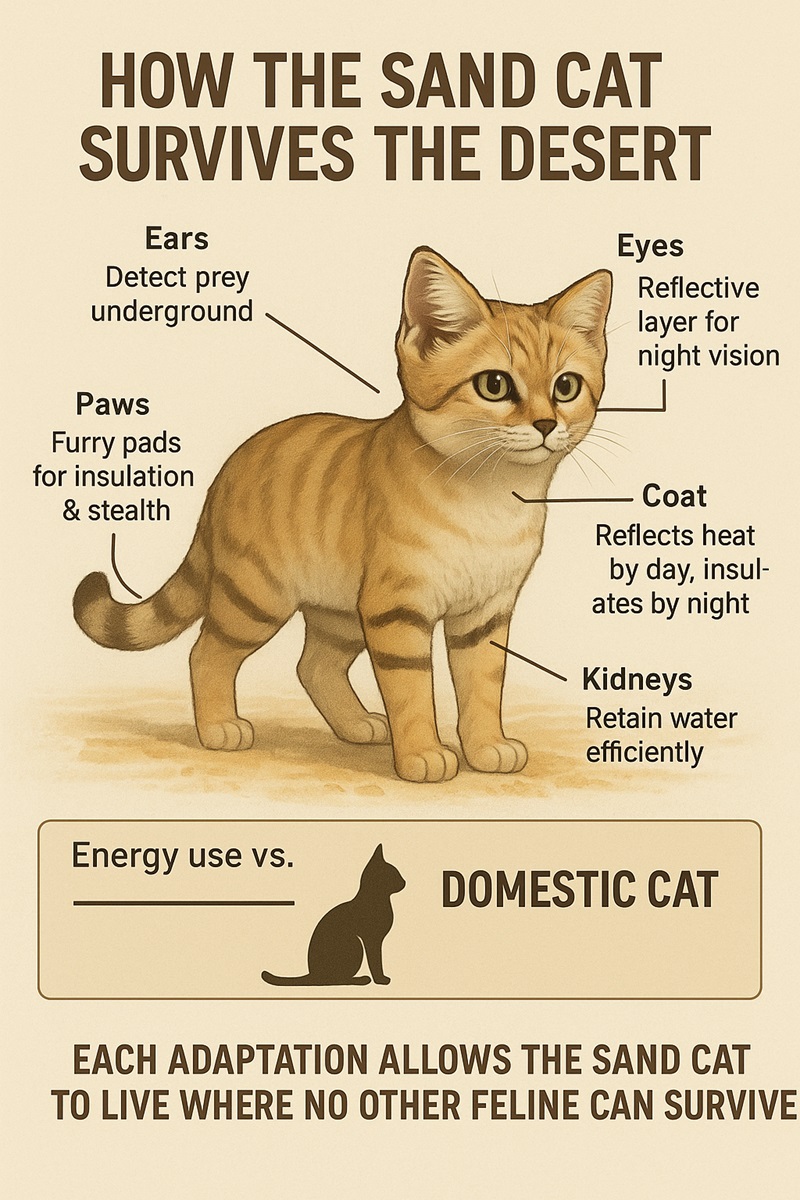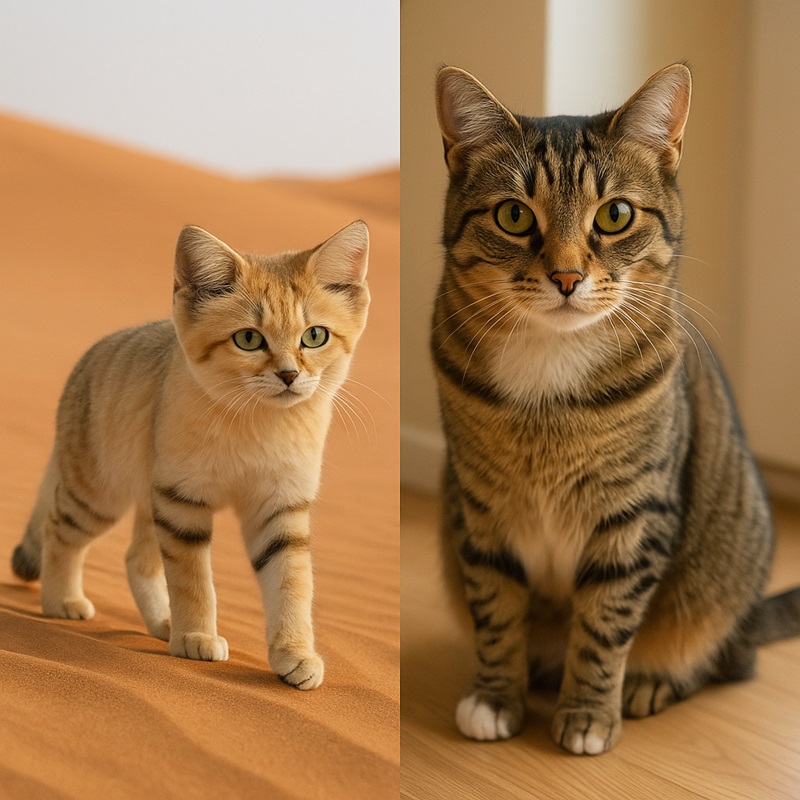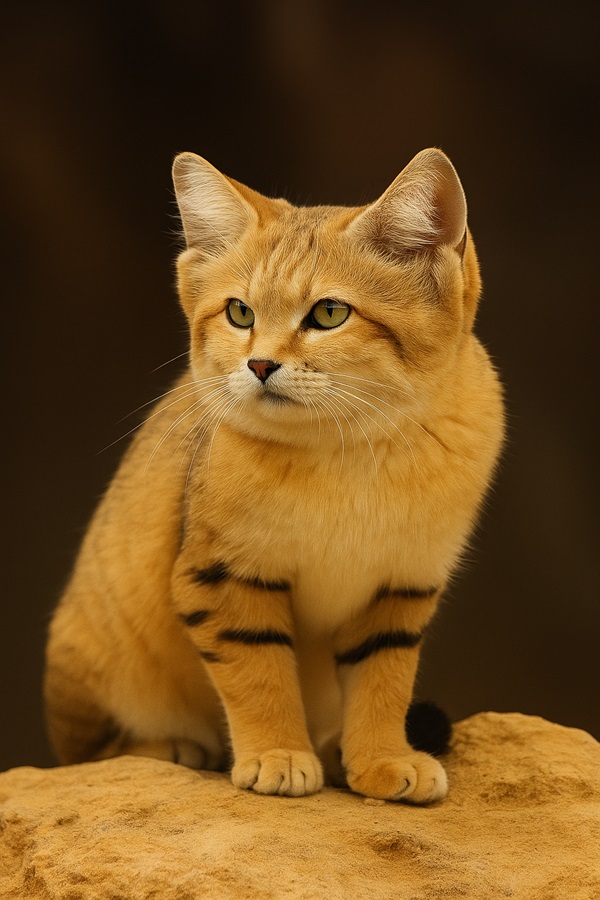Under the blistering sun of the Sahara, a tiny set of paws crosses the dunes—leaving almost no trace behind. This is the sand cat (Felismargarita), the only true desert-dwelling feline on Earth. Small, secretive, and perfectly adapted to extremes, it thrives where few mammals can. Here are seven facts that reveal why the sand cat remains one of nature’s most remarkable survivors.
Sand Cat Appearance and Lifestyle
With its plush, sand-colored coat and oversized ears, the sand cat looks deceptively cute—but every feature has a purpose.
Adults measure about 40–50 cm (16–20 inches) long, with tails adding another 25–30 cm. Their broad heads and short legs are built for digging and stealth, while thick fur hides them from the desert’s brutal heat and cold.
The sand cat’s diet is as tough as its habitat: it preys on gerbils, jerboas, birds, snakes, and lizards, often storing leftovers in burrows.
As nocturnal hunters, they spend their days in abandoned fox holes or self-dug dens, emerging only under cover of darkness.
They live solitary lives, meeting only to mate or raise kittens—and vanish into the dunes without leaving a trace.
Quick Facts: Sand Cat (Felis margarita)
| Feature | Details |
| Average Size | 40–50 cm body; 25–30 cm tail |
| Weight | 2.5–3.5 kg |
| Habitat | Arid deserts (Sahara, Arabian, Central Asia) |
| Diet | Rodents, birds, reptiles, snakes |
| Lifespan | 12–13 years (in captivity) |
| Conservation Status | Least Concern (IUCN) — declining trend |
| Special Adaptation | Fur-covered paws for silent, heat-proof movement |

Where Do Sand Cats Live?
Sand cats inhabit some of the harshest deserts on Earth — including the Sahara (North Africa), Arabian Peninsula, Iran, Pakistan, and Central Asia.
Each region’s subspecies, such as Felis margarita harrisoni in Arabia, has distinct coat shades adapted to local sands.
They prefer flat, open areas with sparse vegetation, avoiding rocky terrain.
Though widespread, populations are fragmented, and sightings are rare — earning the species its nickname, “the ghost of the desert.”
1. The Sand Cat Is a True Desert Specialist
Native to North Africa, the Arabian Peninsula, and parts of Central Asia, the sand cat lives in regions where summer days can reach 50 °C (122 °F) and nights plunge below freezing.
It favors arid plains and shifting dunes with sparse vegetation—landscapes too hostile for most predators.
Unlike other wild cats, it doesn’t need permanent water sources. Every adaptation—from its pale coat that blends with sand to its heat-reflecting ears—allows it to disappear into the desert.
2. It Can Survive Without Drinking Water for Months

The sand cat’s body is a master of water conservation. It extracts all required moisture from its prey—rodents, reptiles, and small birds—while specialized kidneys minimize fluid loss.
Even in drought seasons, it remains hydrated through metabolic water, much like desert foxes or camels.
To scientists, it’s living proof that evolution can turn scarcity into strength.
3. Its Paws Are Built for Silence and Survival

Each paw has a thick pad of soft fur underneath. This furry cushion keeps the cat’s feet safe from the hot sand and helps it walk without a sound.
As it moves, its tracks fade almost right away, leaving no trace behind.
This silent design explains why sand cats are so hard to find in the wild—even with cameras watching day and night.
4. A Master of Stealth and Night Vision
The sand cat rests in underground burrows during daylight and emerges only at night.
Its oversized eyes capture the faintest light, giving it extraordinary night vision—sometimes reflecting an eerie emerald glow.
Guided by keen hearing, it locates prey beneath the sand and pounces with pinpoint accuracy.
Each kill sustains it for days, reducing the need for constant hunting in barren terrain.
5. Sand Cats Communicate Like Miniature Lions
When mating season arrives, these quiet hunters turn surprisingly loud. They produce a deep, bark-like call—unique among small cats—that travels across the dunes to attract partners. Outside that brief window, they live solitary lives, marking territories and avoiding confrontation. Even their kittens, though irresistibly cute, are born ready to adapt—leaving the den after just a few weeks.
Sand Cat vs. Domestic Cat: Worlds Apart, Yet Strangely Familiar
At first glance, the sand cat looks like a house cat that wandered into the desert — wide eyes, rounded face, and soft, sandy fur.
But beneath that cute appearance lies a very different creature, built for survival rather than companionship.
| Feature | Sand Cat | Domestic Cat |
| Habitat | Deserts of North Africa, Arabia, and Central Asia | Human homes and urban environments worldwide |
| Size | 2.5–3.5 kg (5–7 lbs) | 3–6 kg (7–13 lbs) on average |
| Coat | Dense, pale fur with black markings — reflects heat and blends with sand | Wide variety of colors and textures |
| Behavior | Solitary, nocturnal hunter; avoids humans | Social, adaptable, comfortable around people |
| Water Needs | Survives entirely on moisture from prey | Needs regular access to clean water |
| Vocalization | Bark-like mating call; quiet otherwise | Purrs, meows, and vocal communication with humans |
| Domestication | Wild species — not tameable or suited as a pet | Fully domesticated companion animal |
Despite their similar looks, sand cats are not domestic cats in disguise.
They’re true wild predators, finely tuned to the desert’s rhythm — sleeping by day, hunting by moonlight, and vanishing at dawn.
For conservationists, this resemblance is a double-edged sword. It draws public attention but also fuels the illegal pet trade, where sand cats often die in captivity. That’s why experts emphasize: admire them, don’t adopt them.

6. The Species Was Once Thought Extinct in Some Regions
For many years, people believed the sand cat had disappeared from some deserts.
Then in 2017, night-vision cameras in Morocco captured a surprise — several sand cats moving through the dunes after more than ten years without a single sighting.
Soon after, researchers found them again in the UAE and Turkmenistan, proving the species is tougher than it looks.
Today, the sand cat is listed as “Least Concern” on the IUCN Red List. But scientists warn that its numbers are still going down because of habitat loss, off-road vehicles, and the illegal pet trade.
⚠️ Threats Facing the Sand Cat
Even though some populations are returning, dangers remain:
- Habitat Loss: Off-road racing, oil work, and desert building destroy fragile lands.
- Climate Change: Hotter weather and fewer prey make survival harder.
- Illegal Pet Trade: Their cute faces attract buyers, but most don’t live long in captivity.
- Predators & Disease: Stray dogs and feral cats spread sickness and attack them.
Without steady protection, this comeback could fade as fast as it began.
7. Conservation Efforts Are Growing Around the World
Zoos and research centers—from Al Ain Zoo in the UAE to RZSS Highland Wildlife Park in Scotland—are leading breeding programs to keep sand cats healthy and diverse.
Field scientists track wild sand cats with tiny radio collars, while education campaigns teach people not to buy them as pets.
Each effort reminds us that protecting small hunters is key to keeping desert life in balance.
The Sand Cat’s Role in the Desert Ecosystem
As one of the desert’s top small predators, the sand cat keeps rodent and reptile numbers under control.
When sand cats vanish, rodents multiply, damaging plants and loosening the soil. Protecting sand cats helps the desert stay healthy — proof that even the tiniest hunter helps keep the sands alive.
Myth vs. Reality: The Truth About Sand Cats
| Myth | Reality |
| “Sand cats are just wild versions of house cats.” | They are a separate species, adapted to desert extremes. |
| “They make great exotic pets.” | Most die in captivity — they cannot adapt to domestic life. |
| “They’re common in deserts.” | They’re rarely seen; even scientists struggle to study them. |
Why the Sand Cat Matters
The sand cat is more than a rare and cute animal — it’s a sign of a healthy desert.
Where sand cats live, so do gerbils, lizards, and ground birds. These animals form the heart of the desert food chain.
By protecting the sand cat, we protect the entire desert ecosystem that depends on it.
Conclusion
Under the soft light of the desert moon, the sand cat shows nature’s quiet strength.
It drinks no water, leaves almost no trace, and survives where few creatures can.
Its story reminds us that even the smallest life can adapt, endure, and thrive in the harshest places.



